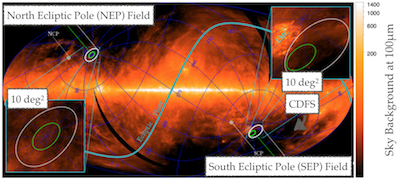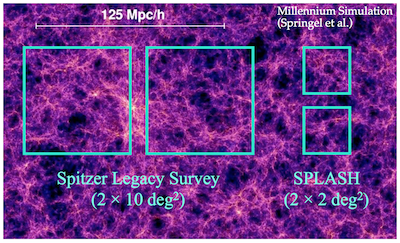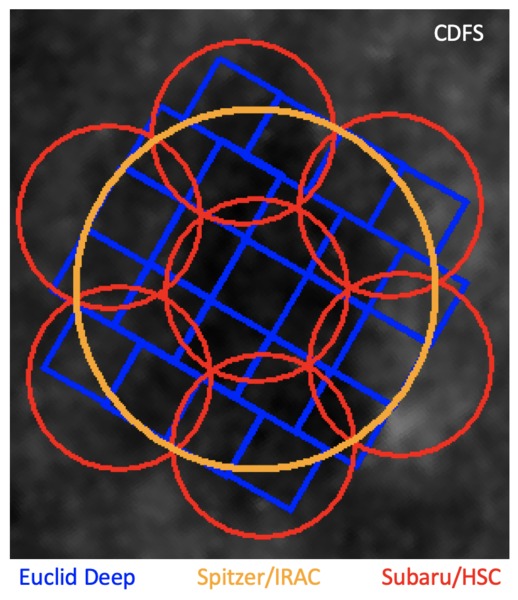
Overview
The Cosmic Dawn Survey is a 50 square degree multi-wavelength survey of the Euclid Deep and Calibration fields. Its goal a coordinated effort to collect complementary multiwavelength data to depths matching Euclids near infrared observations. For example, the survey includes 5286 hours on the Spitzer Space telescope ("Euclid/WFIRST Spitzer Legacy Survey, SLS") to carry out a precursor survey at 3-5μm for future space mission such as Euclid or WFIRST over 20 square degrees to 2 hours per pointing. On the same area, 30 nights of grizY imaging from the Hyper Suprime-Cam (HSC) on the 8-meter Subaru telescope as well as 5 nights of spectroscopy on LRIS and MOSFIRE on the 10-meter Keck telescopes are being obtained ("Hawaii Two-O" (H20) Survey). The 20 square degrees are split between the Chandra Deep Field South (CDFS) and the North Ecliptic Pole (NEP).
Goals
The primary goal is to enable definitive studies of reionization, early galaxy formation (z > 7, less than 700 million years after the Big Bang), and the first massive black holes. The survey parameters are designed to enable stellar mass measurement at 3 < z < 7 (2 billion years of Cosmic time, starting 500 million years after the Big Bang), probe the large scale structure of reionization in the early Universe, and find luminous quasars to the highest redshifts where they exist:
- Probe the assembly of massive galaxies by tracing the evolution of their stellar mass function of 100,000s of glaxies at z > 6 over 20deg2
- Test cosmological models by linking the stellar mass of galaxies to their dark matter halos via clustering
- Constrain the properties of dark energy using the non-linear power spectrum at high redshifts
- Identify the earliest sites of galaxy formation and reionization, and spectroscoipcally confirm high-escaape fraction candidates
- Identify and confirm the first galaxies to quench their star formation in the early universe
The data gained by the Cosmic Dawn Survey will also enhance the cosmological constraints provided by Euclid and WFIRST.
My Contribution
I provided a tool to create a spatial grid of Spitzer Point Source Functions taking into account overlapping frames. Furthermore, I will lead the science group, which will measure the Hα emission for galaxies at z > 4 from the Spitzer [3.6μm]-[4.5μm] color (see Faisst et al. 2016a and Faisst et al. 2019c). This will result in the largest sample with Hα measurements at these redshifts and will build the basis for follow-up observations with JWST (to confirm the line emission and to measure other lines for a subsample of interesting objects).
More on this topic:
Cosmic Dawn webpage Abstract of SLS proposal Faisst et al. (2016a) Faisst et al. (2019c)
SLS and H20 (part of the Cosmic Dawn Survey) cover in total 20 deg2 on two fields (CDFS and NEP). The fields are among the darkest and most observed spots on the sky. Furthermore, they are in the continuous viewing zone of future space telescopes.
The footprints of Euclid/WFIRST Spitzer Legacy Survey (SLS) are shown on top of a simulation of the Cosmic Web (the Dark Matter structure of the Universe). The area is 10 times larger than current Spitzer surveys (e.g., SPLASH), although the depth is slightly shallower. This allows us to uniquely trace the density structure of the universe and to study the dependences of galaxy properties on environment.
The Cosmic Dawn Survey is a coordinated effort to collect complementary multiwavelength data to depths matching Euclids near infrared observations. The above figure shows this complementary approach on the example of the survey footprints of ongoing Subaru/HSC and Spitzer/IRAC coverage in the 10 square degrees Euclid Deep Field in the CDFS.


